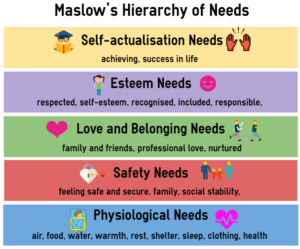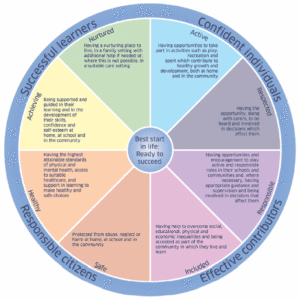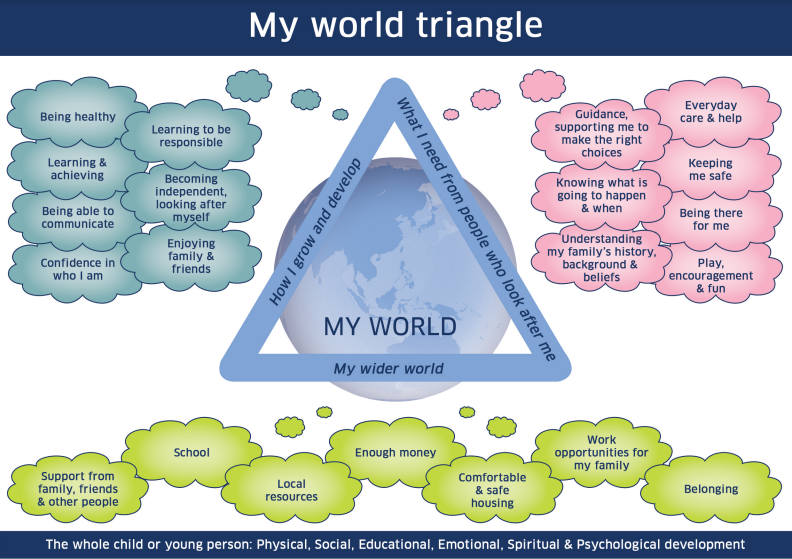![]()
Getting It Right For Every Child (GIRFEC)
Resources
What is it?
“The wellbeing of children and young people is at the centre of GETTING IT RIGHT FOR EVERY CHILD. The approach focuses on eight areas of wellbeing, which children need to develop and achieve their potential… The eight wellbeing indicators help children, parents/carers and practitioners have a shared language and common understanding of wellbeing.”
(Child’s Planning Manual, Scottish Borders Council, April 2021, p. 5)
Shanarri Wellbeing Wheel: Safe, Healthy, Achieving, Nurtured, Active, Respected, Responsible and Included.
 GIRFEC is central to all government policies which support children, young people and their families and is delivered through services and people who work with families. It is built upon the work of Abraham Maslow, with children’s rights and listening to children’s voices underpinning the approach.
GIRFEC is central to all government policies which support children, young people and their families and is delivered through services and people who work with families. It is built upon the work of Abraham Maslow, with children’s rights and listening to children’s voices underpinning the approach.
“GIRFEC is a way for families to work in partnership with people who can support them, such as teachers, doctors and nurses.”
(Getting It Right For Every Child, Scottish Government)
“A shared understanding of wellbeing needs, including planning for children and young people through the GIRFEC approach, is essential to respond to those needs. This makes it easier to work jointly with other organisations and agencies where needed and means that all those working with children and their families across services are using the same language and approach.”
(Realising The Ambition, Education Scotland, 2020, p. 38)
The GIRFEC approach is about how practitioners across all services for children and adults meet the needs of children and young people, working together where necessary to ensure they reach their full potential. It promotes a shared approach and accountability that:
- Builds solutions with and around children, young people and families
- Children and young people get the help they need when they need it
- Supports a positive shift in culture, systems and practice
- Involves working better together to improve life chances for children, young people and families.
The principles of GIRFEC underpin pedagogy and practice in Early Years. The key messages below are intended to stress the importance of ensuring practitioners have a clear understanding of the statutory duties around ensuring the needs of each child are met. Many of the principles and well-being indicators can be met through our professional values, interactions and daily routines.
Further information surrounding the practical implications of GIRFEC can be found at: A guide to Getting it right for every child, Scottish Government, 2012
Child’s Planning Manual: A practitioner’s guide to Getting It Right for Every Child in the Scottish Borders (Scottish Borders Council, 2021) has been developed for all practitioners working directly and indirectly with children to support positive and sustainable wellbeing outcomes for all our children and young people. It was updated in October 2021, and includes all essential paperwork and the Neglect Tool Kit.
Key messages:
- All practitioners have an understanding of ‘Getting It Right For Every Child’ Core Components, Values, Principles and the National Practice Model.
- “Efficient and effective record keeping systems are in place. This includes the management of electronic information which is in line with general data protection requirements and advice on cyber threats. Our staff fully understand and implement their roles and responsibilities in relation to information management.” (A Quality Improvement Framework for Early Learning and Childcare Sectors, Sept 2025, p24)
- A child’s personal plan and chronologies reflect the holistic needs of that child to support wellbeing and development, e.g. wellbeing indicators, allergies, medication and dietary requirements. This should be in consultation with all significant partners, e.g. parents, practitioners, managers and external agencies and reflect the child’s opinions.
- The curriculum is accessible to all with appropriate support given when needed.
- Learning journals reflect the holistic needs of the child as a learner and as an individual.
- Practitioners are fully trained in child protection policies and procedures.
- Health and wellbeing indicators are embedded in practice and the language of these are used by practitioners and by children.
- There is clear understanding of the procedures in place when there are concerns about a child.
Ways we can do this:
The setting: “We work proactively with children, families and other professionals to identify support needs and have clear strategies in place to ensure that children’s wellbeing is sustained.
Our approach to personal planning considers best practice guidelines and is grounded in the Getting it Right for Every Child (GIRFEC) framework, utilising wellbeing indicators to assess and plan for children’s overall wellbeing. The indicators provide us with a common language for assessing and discussing children’s strengths, needs and progress with families and other professionals.” (A Quality Improvement Framework for Early Learning and Childcare Sectors, Sept 2025, p47)
Personal care and learning needs reflect family preferences, for example, religious considerations, dietary requirements, same-gender parents, family makeup or medical needs.
An understanding of nurturing approaches, attachment and child development is evident in planning to develop a wide range of skills and support resilience and self esteem.
All behaviour is recognised as communication. Relationships reflect a nurturing approach.
Effective communication with families enables responsive care to support children through changing circumstances using creative approaches, which are well matched to the needs of families and are used to engage families throughout their contact with the setting.
Account is taken of children’s rights and is considered in respect of their stage of development including when planning for learning.
Family learning opportunities help parents to understand the significant impact of the home learning environment at all stages of their children’s education. (Flying Start, PoPPs, Incredible Years and PEEP)
Practitioners: Have a shared understanding of wellbeing and children’s rights which underpins all aspects of GIRFEC. Practitioners make use of the resources available, such as, SBC’s Child’s Planning Manual, when working with children and their parents or carers to ensure best practice when focusing on GIRFEC planning and how best to support them.
Attend regular child protection training and ensure that communication in child protection matters are of a high standard.
Understand the wide range of duties required to ensure that all children and young people are safe, well cared for, and enabled to flourish.
Recognise the need to support vulnerable families and carers as well as individual learners; while ensuring their rights are respected and promoted.
Actively work to break down cultural and language barriers.
Work to reduce the gap in outcomes between the most and least deprived families using our service by trying to reduce any barrie.rs, e.g cost, clothing, toy, library etc.
The environment: The setting and equipment are safe, secure and well-maintained; the spaces and resources are accessible to all children while providing support and challenge.
The layout of spaces and inclusion of resources takes account of the children’s interests and opinions. The children are included in making decisions regarding changes to the spaces and resources.


